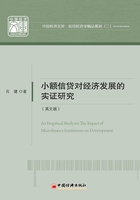
Chapter 2 Literature Review
1. MFIs: The Balance between Increasing Profits and Social Impact
"From the point of view of MFIs, the MFIs should increase average loan size, which is a cost-effective way to operation and to pursue profit."(1) However, MFIs would shift focus to wealthier borrowers, those can absorb larger loans and even at the cost of the sacrifice of outreach to the poorest households whose promise for repayment is much more guaranteed.
"McIntosh and Wydick (2005) argue that MFIs could support their business by cross-subsidizing their clients between poor clients and most profitable clients."(2) When competition eliminates rents on profitable borrowers, it will yield a new equilibrium that poor borrowers will be worse off. MFIs will be interested in keeping their market power in such a situation. Otherwise, MFIs will disproportionally diminish outreach to the poor. Thus, if MFIs do not share information on all borrowers, the most impatient borrowers will apply for multiple loans across different MFIs. This situation will create a negative externality problem and diminish borrowers' repayment rate, reducing the incentives that MFIs face for serving the poorest borrowers.
Assefa et al. (2012) look at the relationship between MFIs' performance and competition. This paper found that competition negatively affects vari-ous measures of MFIs' performance such as outreach and return on assets. "The result shows that an increasing competition among MFIs on the one hand, a decrease of each MFI's performance on the other. The empirical research was based on data from MFIs for the period 1995—2008 and includes 362 MFFS in 73 countries ."(3)
De Quidt et al. (2013) find that in a competitive equilibrium, borrowers face lower incentives to repay their debt because borrowers can easily default their debt and go to a new Microfinance Institution because Microfinance Institutions cannot access borrowers' credit history. In a competitive market structure with an asymmetric information and free entry, MFIs would keep a high market share. Otherwise, MFIs would undertake credit rationing practices to keep the best customers and protect their profit margins, further reducing outreach to the poor clients.
Cull et al (2007) argue that MFIs' social goal to reduce poverty by providing financial services to low-income communities was unmet. "The empirical research was based on data from 124 institutions in 49 countries."(4) This paper found that MFIs that served the poorest did not earn a profit. It showed that it's a trade-off between profitability and serving the poorest household.
Marr and Awaworyi (2012) examine how to assess MFIs' social performance and choose four indicators, including loans per loan officers, MFIs' regulation status, MFIs' assets and the profit status of MFIs affect MFIs' ability to perform socially. The empirical research was based on data from 878 Microfinance Institutions for a period of 11 years (2000—2010). This paper found that older MFIs, as well as regulated ones, tend to perform less socially as compared to younger and non-regulated MFIs.
Vicki (2012) examines the relationship between capital structure and Microfinance Institutions' sustainability. The empirical research was based on data from MFIs in Africa, East Asia, Eastern Europe, Latin America, the Middle East, and South Asia for the years from 2003 to 2006. "This paper found that MFIs' capital structure did not affect MFIs operational self-sufficiency."(5)
To sum up, most researchers insist that Microfinance Institutions that increase their profit may bring about a negative impact on the poor people. Generally speaking, Microfinance Institutions cannot achieve both goals at the same time.